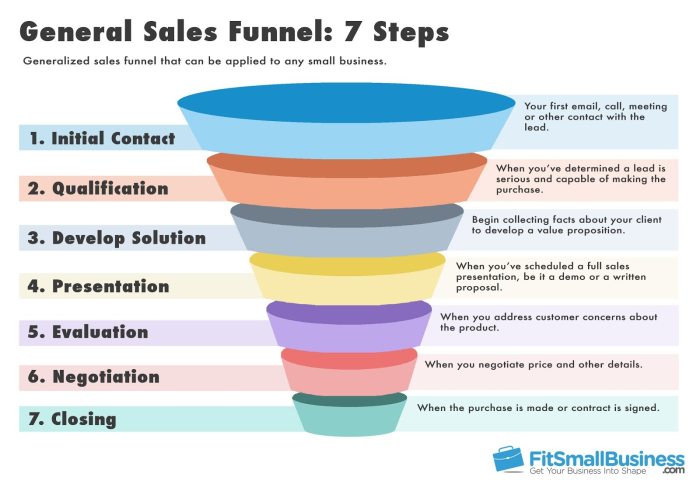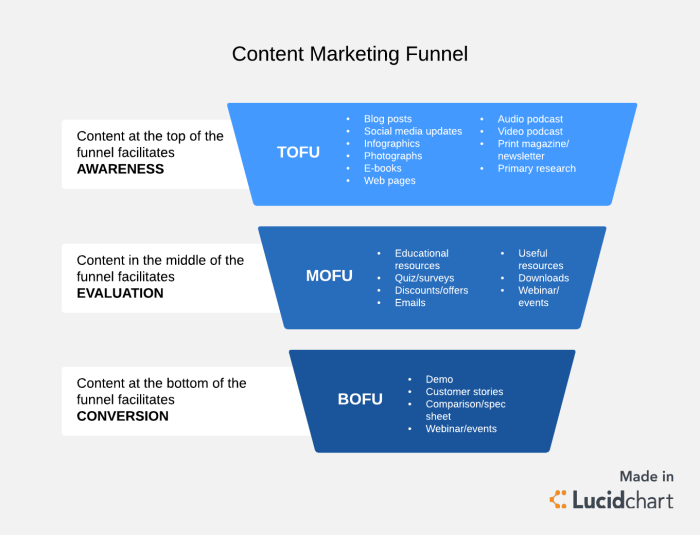Developing a Sales Funnel Content Plan sets the stage for this enthralling narrative, offering readers a glimpse into a story that is rich in detail with american high school hip style and brimming with originality from the outset.
Get ready to dive into the world of sales funnels, content planning, and audience research as we explore the key elements that drive successful marketing strategies.
Understanding Sales Funnels

A sales funnel is a marketing concept that represents the journey a potential customer takes from being aware of a product or service to making a purchase. It is crucial in marketing as it helps businesses understand and optimize the customer’s path to conversion.
Different Stages of a Sales Funnel, Developing a Sales Funnel Content Plan
- Awareness: This is the stage where a potential customer first becomes aware of a product or service. It is essential to create brand awareness and attract the attention of the target audience.
- Interest: Once a customer is aware of the product, they move to the interest stage where they seek more information and evaluate the offering. Businesses need to provide valuable content to engage and educate potential customers.
- Decision: In this stage, the customer is ready to make a decision and purchase the product or service. It is crucial to provide clear information, address any concerns, and offer incentives to encourage the purchase.
- Action: The final stage of the sales funnel where the customer takes the desired action, such as making a purchase. It is essential to make the buying process smooth and convenient to increase conversion rates.
Importance of Sales Funnels
A sales funnel helps in converting leads into customers by guiding potential buyers through a structured process that moves them closer to making a purchase. By understanding the different stages of the sales funnel, businesses can tailor their marketing strategies and content to meet the needs of customers at each stage, ultimately increasing conversion rates and driving sales.
Developing a Content Plan
Creating a solid sales funnel content plan involves several key steps to ensure that your content is effectively guiding potential customers through the sales process. It is crucial to align your content with each stage of the funnel to provide the right information at the right time and nurture leads towards conversion.
Aligning Content with Each Stage of the Funnel
To create a successful content plan, you must tailor your content to match the different stages of the sales funnel:
- Awareness Stage: At this stage, focus on creating educational and informative content that addresses the pain points of your target audience. Examples include blog posts, infographics, and social media posts.
- Interest Stage: As leads move to the interest stage, provide more in-depth content that showcases your products or services. Consider using videos, webinars, and whitepapers to engage potential customers.
- Decision Stage: In the decision stage, offer content that helps prospects make a final purchasing decision. Case studies, testimonials, and product demos can be effective in convincing leads to convert.
- Action Stage: Finally, at the action stage, provide content that encourages leads to take the desired action, such as special offers, free trials, or consultation requests.
Examples of Content Types for Different Funnel Stages
- Blog Posts: Ideal for creating awareness and providing valuable information to attract potential customers.
- Videos: Engaging and versatile, videos can be used at various stages of the funnel to showcase products, share customer testimonials, or provide tutorials.
- Case Studies: Effective in the decision stage, case studies demonstrate real-life success stories and build credibility with leads who are close to making a purchase.
- Webinars: Perfect for the interest stage, webinars allow you to engage with leads in a more interactive and educational format.
Target Audience Research

When it comes to developing a killer sales funnel content plan, understanding your target audience is key. Conducting thorough research on your audience helps you tailor your content to their specific needs and preferences, ultimately leading to higher conversion rates and more sales.
Significance of Target Audience Research
- Identify the pain points: By researching your target audience, you can pinpoint the specific challenges and issues they are facing. This allows you to create content that addresses these pain points directly, making your offer more appealing.
- Understand their needs: Research helps you uncover what your audience needs and desires. By knowing their preferences, you can craft content that resonates with them and motivates them to take action.
- Improve targeting: The more you know about your target audience, the better you can target your marketing efforts. This leads to more effective campaigns and higher ROI.
Methods for Identifying Audience Pain Points and Needs
- Surveys and questionnaires: Direct feedback from your audience through surveys can provide valuable insights into their pain points and needs.
- Social media listening: Monitor conversations on social media platforms to understand what your audience is talking about and what problems they are facing.
- Analytics and data analysis: Use data from your website, email campaigns, and other sources to identify patterns and trends that reveal audience needs and pain points.
Influence of Understanding Target Audience on Content Plan
- Personalized content: Knowing your audience allows you to create content that speaks directly to their needs and interests, increasing engagement and conversions.
- Content alignment: Understanding your audience helps you align your content with their preferences, ensuring that every piece of content in your sales funnel resonates with them.
- Improved targeting: With a deep understanding of your target audience, you can segment your audience and deliver targeted content that meets their specific needs at each stage of the sales funnel.
Content Creation and Distribution: Developing A Sales Funnel Content Plan
When it comes to developing a sales funnel content plan, creating engaging content is key to attracting and retaining your target audience at each stage of the funnel. By providing valuable and relevant information, you can nurture leads and guide them towards making a purchase. Utilizing various channels for content distribution is crucial in reaching a wider audience and increasing brand visibility. Repurposing content effectively across different stages of the funnel can help reinforce your message and keep your audience engaged.
Creating Engaging Content
To create engaging content for each stage of the funnel, consider the specific needs and interests of your target audience. Tailor your content to address their pain points and provide solutions that showcase the benefits of your product or service. Use a mix of formats such as blog posts, videos, infographics, and social media posts to appeal to different preferences. Incorporate storytelling and interactive elements to captivate your audience and encourage interaction.
Utilizing Various Channels for Content Distribution
When distributing content, leverage a mix of channels such as your website, social media platforms, email marketing, and paid advertising. Each channel serves a different purpose in reaching and engaging your audience. By diversifying your distribution strategy, you can maximize your reach and connect with potential customers across multiple touchpoints. Monitor the performance of each channel to identify which ones are most effective in driving conversions.
Repurposing Content Effectively
Repurposing content involves taking existing content and adapting it for different stages of the funnel or different channels. For example, you can turn a blog post into a series of social media posts, a webinar into a downloadable guide, or a customer testimonial into a case study. By repurposing content, you can extend its lifespan, reach new audiences, and reinforce your messaging. Make sure to optimize the content for each platform and audience to maximize its impact.
Analyzing and Optimizing
In the world of sales funnels, analyzing and optimizing your content plan is crucial for success. By leveraging analytics, you can measure the effectiveness of your strategies and make data-driven decisions to improve your conversion rates.
Role of Analytics
Analytics play a vital role in evaluating the performance of your sales funnel content plan. By tracking key metrics at each stage of the funnel, you can gain valuable insights into customer behavior, identify bottlenecks, and optimize your content for better engagement and conversion.
- Visitor Traffic: Monitor the number of visitors at each stage of the funnel to understand where your audience is dropping off.
- Conversion Rate: Track the percentage of visitors who take the desired action, such as signing up for a newsletter or making a purchase.
- Time on Page: Analyze how much time visitors spend on each page to identify areas for improvement in content engagement.
- Bounce Rate: Measure the percentage of visitors who leave your site without exploring further, indicating potential issues with your content or site usability.
Optimization Strategies
Based on analytical insights, you can optimize your content plan to enhance the overall performance of your sales funnel. Here are some strategies to consider:
- Content Personalization: Tailor your content to meet the specific needs and preferences of your target audience for a more personalized experience.
- A/B Testing: Experiment with different variations of your content to determine which performs best and optimize based on the results.
- Optimize CTAs: Improve the effectiveness of your calls-to-action by testing different placements, wording, and designs to drive more conversions.
- Mobile Optimization: Ensure your content is optimized for mobile devices to provide a seamless experience for users accessing your site on smartphones or tablets.